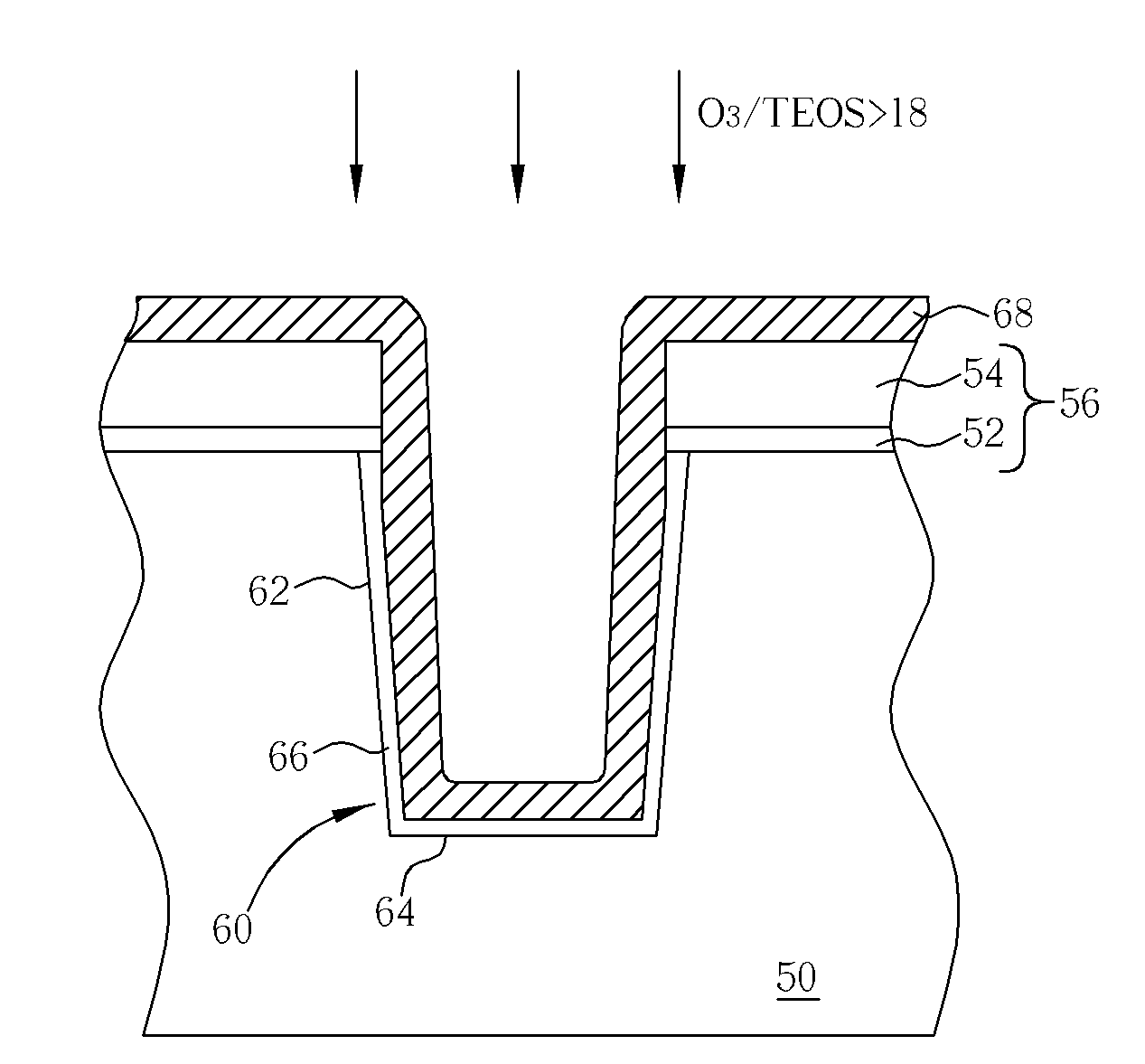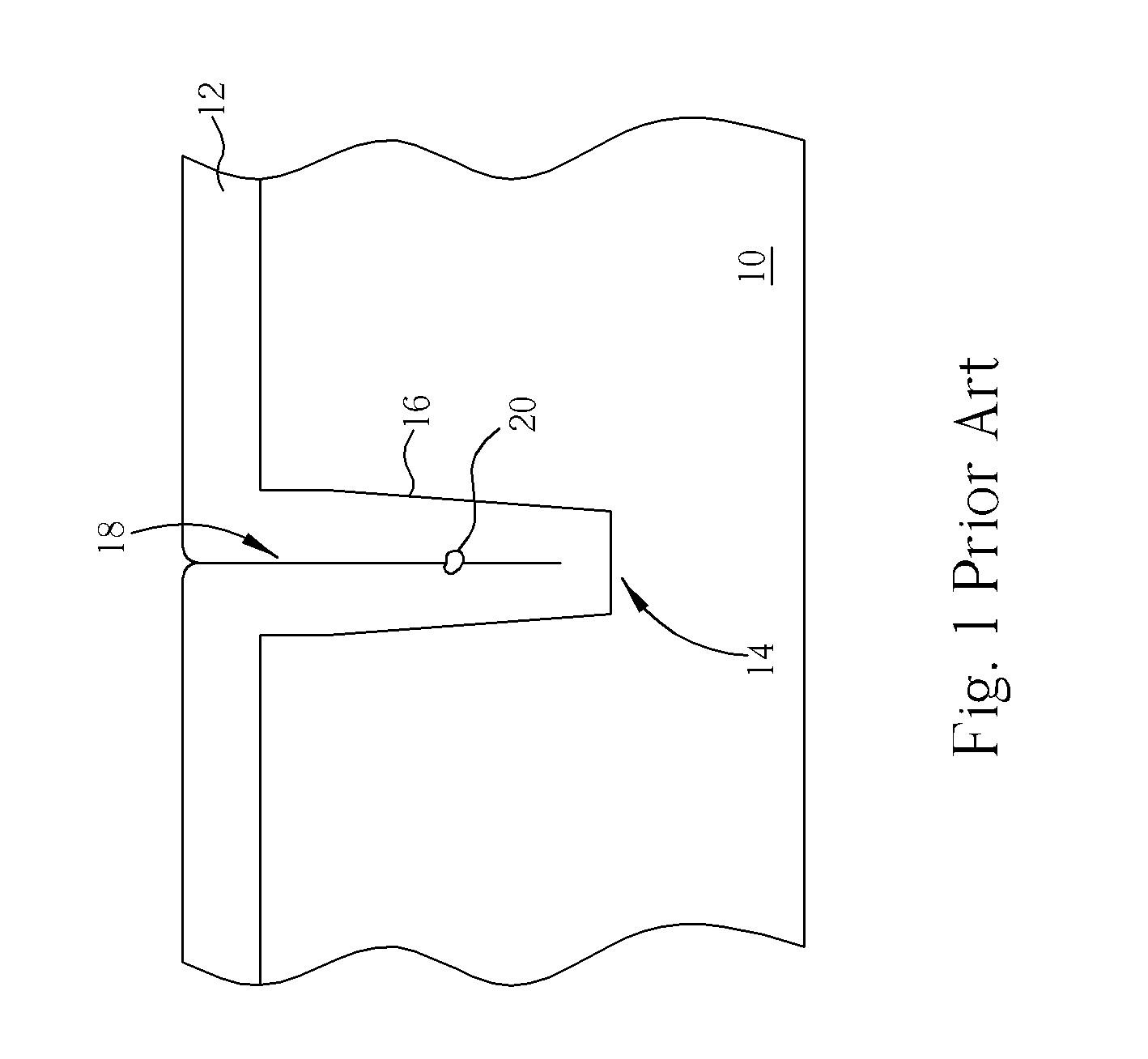Sti of a semiconductor device and fabrication method thereof
a technology of semiconductor devices and fabrication methods, which is applied in the direction of semiconductor/solid-state device manufacturing, electrical equipment, basic electric elements, etc., can solve the problems of ozone-assisted sacvd, deposited sacvd film is apt to shrink, and conventional cvd methods have no longer provided satisfactory step coverage when dealing with high aspect ratio trenches, etc., to achieve low deposition sensitivity, good gap filling capacity, and convenient quality
- Summary
- Abstract
- Description
- Claims
- Application Information
AI Technical Summary
Benefits of technology
Problems solved by technology
Method used
Image
Examples
first embodiment
[0020]Please refer to FIGS. 2-6. FIGS. 2-6 are sectional schematic diagrams of a fabrication process of an STI according to the present invention. First, a semiconductor substrate 50, such as a silicon substrate, is provided, as shown in FIG. 2. Then, a pad oxide layer 52 is formed on the semiconductor substrate 50 with a thickness of about 30 angstroms to 200 angstroms, wherein the pad oxide layer 52 may be formed by a CVD process or a thermal oxidation process. After the formation of the pad oxide layer 52, a pad nitride layer 54 with a thickness of about 500 angstroms to 2000 angstroms is formed covering the pad oxide layer 52. The pad oxide layer 52 and the pad nitride layer 54 compose a mask layer 56.
[0021]As shown in FIG. 3, a photolithography process and an etching process are sequentially performed to form an opening 58 in the mask layer 56. Then, the mask layer 56 is taken as an etching mask during another etching process to remove a portion of the semiconductor substrate 5...
second embodiment
[0025]In a semiconductor wafer, sallow trench isolations for electrically isolating elements may have different sizes and aspect ratios according to the design of electric circuits. For shallow trenches with various aspect ratios, each deposition process may produce silicon oxide layers with various gap filling performances. Therefore, the present invention would introduce the method of forming silicon oxide layers into a plurality of shallow trenches with different aspect ratios at the same time for fabricating shallow trench isolations in a single semiconductor wafer with good performance.
[0026]Please refer to FIGS. 7-11. FIGS. 7-11 are sectional schematic diagrams of fabrication process of a semiconductor device 136 according to a second embodiment of the present invention. Referring to FIG. 7, the semiconductor device 136 comprises a semiconductor substrate 100. A pad oxide layer 102, a pad nitride layer 104, and electrical elements (not shown) are positioned on the surface of t...
PUM
| Property | Measurement | Unit |
|---|---|---|
| width | aaaaa | aaaaa |
| aspect ratios | aaaaa | aaaaa |
| pressure | aaaaa | aaaaa |
Abstract
Description
Claims
Application Information
 Login to View More
Login to View More - R&D
- Intellectual Property
- Life Sciences
- Materials
- Tech Scout
- Unparalleled Data Quality
- Higher Quality Content
- 60% Fewer Hallucinations
Browse by: Latest US Patents, China's latest patents, Technical Efficacy Thesaurus, Application Domain, Technology Topic, Popular Technical Reports.
© 2025 PatSnap. All rights reserved.Legal|Privacy policy|Modern Slavery Act Transparency Statement|Sitemap|About US| Contact US: help@patsnap.com



